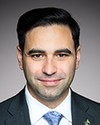Thank you, Mr. Chair. Good morning.
Good morning to all the committee members. Thanks for inviting me. It's great to be here today, and I'm really looking forward to having a thoughtful discussion on disability inclusion and on what more we can do to create a barrier-free Canada.
First and foremost, I want to take a moment to thank the committee and its members for taking the time for the work on this study. I can tell you that, as Minister of Diversity, Inclusion and Persons with Disabilities, my goal is to build a Canada where everyone, regardless of their background or ability, has an equal opportunity to succeed.
Since day one, we've been working in partnership with Canada's disability community in the true spirit of “nothing without us” to create a barrier-free Canada, but that doesn't just happen by accident. It takes deliberate and persistent action, and that's exactly what we're busy delivering on.
Since being elected, we have made a lot of progress towards making Canada more accessible, particularly through the implementation of the Accessible Canada Act. In fact, this year marks the fifth anniversary since the act came into force. I want to take a moment, Mr. Chair, to highlight some of the incredible things that we have accomplished together under the Accessible Canada Act.
At the federal level, our government has implemented critical regulations that require federally regulated entities to transparently plan and to report to the public on their efforts to remove accessibility barriers. Accessibility Standards Canada was established to develop national accessibility standards in all the priority areas set out by the Accessible Canada Act.
We also launched Canada's first-ever disability inclusion action plan. It is a road map to get to a barrier-free Canada by 2040. It has four particular pillars. The first is around strengthening financial security. The second is on employment. The third is around building accessible communities. The fourth is really about modernizing the way that we look at disability.
Canada's first-ever chief accessibility officer was appointed. The office of the accessibility commissioner was also created under the act. We have also created a new statutory benefit to supplement the incomes of working-age persons with disabilities, and we are on track to deliver the Canada disability benefit in July 2025.
In the spring of this year, we hosted Canada's first-ever Air Accessibility Summit, bringing together experts, people from the industry and persons with disabilities themselves to work together to find solutions when it comes to disability inclusion within the transportation sector. Just this past summer, we launched an employment strategy for persons with disabilities to make workplaces and our economies more accessible.
Like I said, we have accomplished a lot when it comes to promoting disability inclusion in Canada, and these aren't just words. This is real, tangible work on the ground, and I can tell you the impact that is taking place in communities and for Canadians right across this country.
I just want to take a moment to give you an example of how our work is changing lives and communities. Like I said, this past summer, we launched Canada's first-ever employment strategy for persons with disabilities. One of the programs that fall under the strategy is called the opportunities fund. Through this fund, we give grants and contributions to businesses and organizations to make their workplaces more accessible. We help match the skills of persons with disabilities with the jobs of the day that are needed to be filled and also help persons with disabilities actually find and keep meaningful jobs.
One organization that we funded is the Eastern Ontario Training Board, and I want to share with you Levi's story. Levi is a person with a disability who had been out of work for about a year, and he was connected to the Eastern Ontario Training Board. There, he got help writing his résumé and finding a job that actually fits his skills. They also provided him with a bus pass so that he could actually get to the interview and get to his job. They also provided him with the equipment that was needed for his disability to ensure that he can fully participate in the workplace of his choice. Not only did they help him find a job and prepare for the job, but they also supported him while he was employed.
It's not just about recruitment of persons with disabilities. It's also about retention and making sure people are able to fully participate in the workforce without any barriers.
This is just one of the hundreds of projects that we funded, and I can tell you the real difference that it is having in communities on the ground. The reality is that, if we want our communities, our economies and our country to truly reach their full potentials, it all starts by making them more accessible. Also, while we have accomplished a lot, we know that there's a lot more work that needs to happen in building a truly barrier-free Canada.
It's work that we must do together because, at the end of the day, creating a barrier-free Canada requires a team Canada approach. I always say, in Canada, diversity is a fact but inclusion is a choice. I can tell you that, as a government, we have been very persistent and deliberate about making that choice to be inclusive, whether it's the choice to promote accessibility or the choice to break down those barriers, because we know that, when we make that choice to include people, Canada and Canadians win.
I'm really looking forward to having a robust discussion.
I forgot to mention that I'm joined by my wonderful team of officials, who work extremely hard every single day on behalf of Canadians.
I'm really looking forward to having a meaningful, thoughtful discussion on removing barriers for persons with disabilities in this country.
Thank you.




